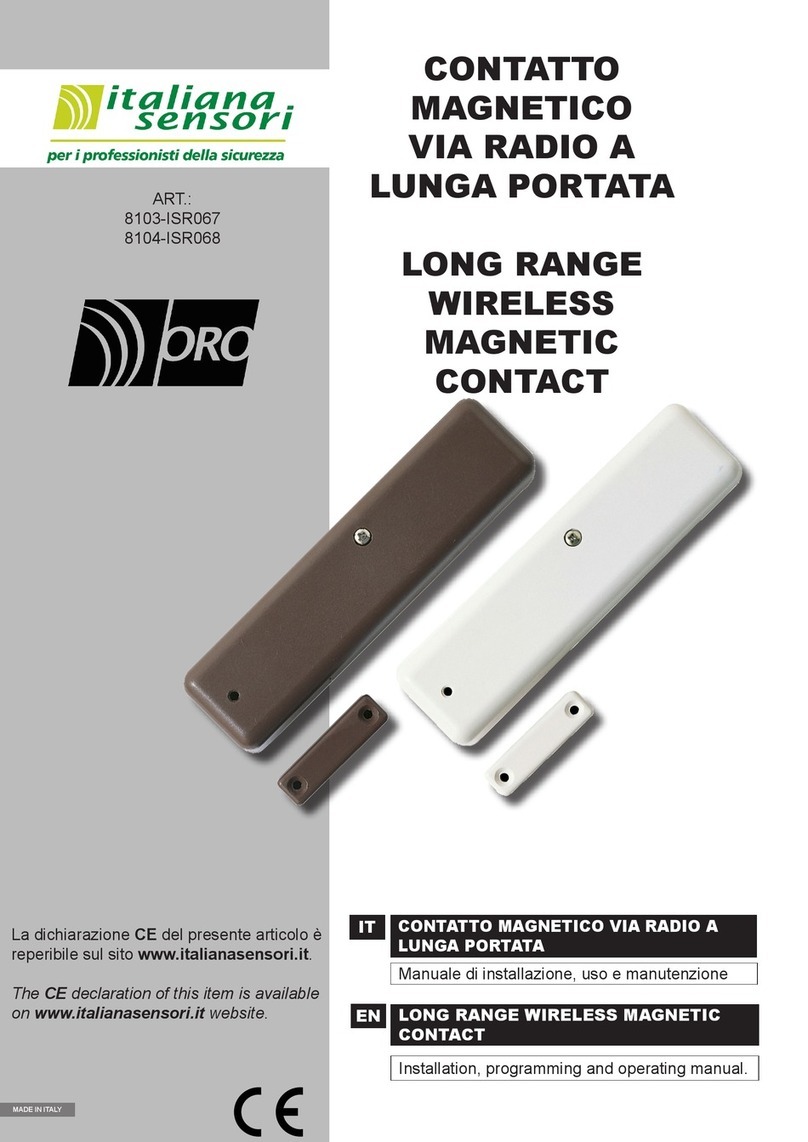
2
ITALIANA SENSORI
1. INTRODUZIONE
I rilevatori serie TENDA sono stati sviluppati per la protezione
di porte e nestre; essi sono rappresentativi del più alto livello
tecnologico fra i rilevatori anti intrusione a tripla tecnologia gestiti
da microprocessore. Il rilevatore TENDA/U è stato progettato
per essere utilizzato con qualsiasi sistema via radio e qualsiasi
protocollo di trasmissione. Il prolo snello rende possibile
l’installazione tra tapparelle/persiane e nestre. Il rilevatore è
composto da due sensori ad infrarosso ed una microonda a 24
GHz; l’antimascheramento è stato progettato utilizzando sensori
ad IR attivi che, attraverso le lenti di Fresnel, hanno la capacità
di rilevare ostacoli volontariamente apposti sulla lente stessa per
impedire il rilevamento (spray, nastro adesivo, carta ecc.).
Utilizzando la funzione WIN (Wired Interface Network) è possibile
alimentare il dispositivo attraverso l’alimentazione principale,
mantenendo la Microonda sempre accesa ed avendo dunque le
stesse prestazioni di un rilevatore lare; tramite la funzione WIN
è inoltre possibile eliminare l’inibizione dopo la prima rilevazione.
1.1 CARATTERISTICHE GENERALI
• Contenitore in policarbonato e lenti di Fresnel resistenti ai
raggi UV.
• Design estetico e meccanico particolarmente curato.
• Scheda elettronica alloggiata in un compartimento ad
elevato grado IP (IP55).
• Conforme alle norme EN 50131 grado 3.
• Funzione CWS®(Cross Walking Sensibility): permette di
discriminare la direzione di attraversamento.
• Funzione WIN: alimentazione tramite rete principale.
INDICE
- Istruzioni originali -
1. INTRODUZIONE................................................................................................ 2
1.1 CARATTERISTICHE GENERALI........................................................... 2
1.2 CARATTERISTICHE TECNICHE........................................................... 3
1.3 IDENTIFICAZIONE DELLE PARTI......................................................... 3
1.4 DOTAZIONI DI SERIE............................................................................4
2. PRINCIPI DI FUNZIONAMENTO ...................................................................... 4
2.1 FUNZIONE TEST...................................................................................4
2.2 INIBIZIONE ............................................................................................4
2.3 FUNZIONE WIN .....................................................................................4
3. INSTALLAZIONE............................................................................................... 5
3.1 AVVERTENZE GENERALI..................................................................... 5
3.2 MONTAGGIO DEL RILEVATORE .......................................................... 5
3.3 CABLAGGIO DEL RILEVATORE .......................................................... 5
3.4 CONFIGURAZIONE DEL RILEVATORE................................................ 6
3.4.1 Descrizione dei DIP-switch.......................................................... 6
3.4.2 Descrizione dei LED.................................................................... 8
3.4.3 Installazione interna/esterna ....................................................... 8
3.4.4 Funzione CWS®..........................................................................9
3.4.5 Sensibilità PIR.............................................................................9
3.4.6 Antimascheramento (8032-ISR023 e 8033-ISR024)................... 9
3.5 INSTALLAZIONE TIPICA .......................................................................9
3.6 TARATURA DEL SENSORE ................................................................ 10
3.7 DETERMINAZIONE AREA DI COPERTURA....................................... 10
4. ACCESSORI DISPONIBILI ............................................................................. 11
4.1 STAFFA ................................................................................................ 11
4.2 SPESSORI ........................................................................................... 11
4.3 CUNEO ................................................................................................ 11
5. MANUTENZIONE E VERIFICHE PERIODICHE ............................................. 12
6. SMALTIMENTO E ROTTAMAZIONE.............................................................. 12
Le informazioni riportate in questo manuale sono state compilate con cura, tuttavia
l’azienda produttrice non può essere ritenuta responsabile per eventuali errori
e/o omissioni. L’azienda si riserva il diritto di apportare in ogni momento, e senza
preavviso, miglioramenti e/o modiche ai prodotti descritti nel presente manuale.
L’azienda pone particolare attenzione al rispetto dell’ambiente. Tutti i prodotti ed i
processi produttivi sono progettati con criteri di eco-compatibilità.
Il presente articolo è stato prodotto in Italia.
L’azienda ha un sistema di gestione della qualità certicato secondo la norma
ISO 9001:2008 (n° 4796 - A)
L’azienda ha un sistema di gestione ambientale certicato secondo la norma
ISO 14001:2004 (n° 4796 - E)
L’azienda ha un sistema di gestione della salute e sicurezza sul lavoro
certicato secondo la norma ISO 45001:2018 (n° 4796 - I)
The informations in this manual have been issued with care, anyway the
manufacturer will not be responsible for any errors or omissions. The manufacturer
reserves the rights to improve or modify the products described in this manual at
any times and without advance notice. The manufacturer pays particular attention
to environment respect. Each product and each process have been designed with
eco-compatibility criteria. This product has been made in Italy.
The company has a certied system of quality management according to ISO
9001:2008 (n° 4796 - A) standard.
The company has a certied system of environmental management according
to ISO 9001:2004 (n° 4796 - E) standard.
The company has a certied system of health and work security management
according to ISO 45001:2018 (n° 4796 - I) standard.
- Translation of the original instructions (original instructions in Italian) -
CONTENTS
1. INTRODUCTION ............................................................................................... 2
1.1 GENERAL FEATURES ..........................................................................2
1.2 TECHNICAL FEATURES ....................................................................... 3
1.3 PARTS IDENTIFICATION.......................................................................3
1.4 STANDARD EQUIPMENT...................................................................... 4
2. UNIT FEATURES............................................................................................... 4
2.1 TEST FUNCTION................................................................................... 4
2.2 INHIBITION MODE.................................................................................4
2.3 WIN FUNCTION..................................................................................... 4
3. INSTALLATION ................................................................................................. 5
3.1 GENERAL PRECAUTIONS ................................................................... 5
3.2 INSTALLING THE DETECTOR..............................................................5
3.3 DETECTOR WIRING ............................................................................5
3.4 DETECTOR SET-UP..............................................................................6
3.4.1 DIP-switches conguration.......................................................... 6
3.4.2 Description of the LEDs............................................................... 8
3.4.3 Outdoor/indoor Installation .......................................................... 8
3.4.4 CWS®feature ..............................................................................9
3.4.5 PIR sensibility..............................................................................9
3.4.6 Antimasking (8032-ISR023 and 8033-ISR024)........................... 9
3.5 TYPICAL INSTALLATION....................................................................... 9
3.6 SENSOR SETTING.............................................................................. 10
3.7 DETERMINING THE DETECTION AREA............................................ 10
5. AVAILABLE ACCESSORIES .......................................................................... 11
4.1 BRACKET............................................................................................. 11
4.2 SPACERS............................................................................................. 11
4.3 WEDGE................................................................................................ 11
5. MAINTENANCE AND PERIODIC CHECKS ................................................... 12
6. DISPOSAL AND SCRAPPING........................................................................ 12
1. INTRODUCTION
TENDA series detectors have been developed for the protection
of doors and windows; they represent the highest level of
technology for microprocessor-controlled triple-technology
intrusion prevention detectors.
The TENDA/U detector has been developed to be combined
with any radio-based system and any transmission protocol. The
thin prole offers installation between roller shutters/shutters and
windows. The detector consist of two infra-red sensors and one
24 GHz microwave; the anti-masking is designed using active
IR sensors which, through Fresnel lenses, have the capacity
to detect obstacles voluntarily afxed on the lens to prevent
detection (spray, adhesive tape, paper, etc.).
Using the WIN function (Wired Interface Network) it is possible
to power the devices from the mains, keeping the Microwave on
and therefore offering the same performance as a wired detector;
through the WIN function it is also possible to eliminate inhibition
mode after the rst detection.
1.1 GENERAL FEATURES
• Casing in polycarbonate and Fresnel lenses UV resistant.
• Carefully developed aesthetic and mechanical design .
• Electronic board built-in in a compartment matching with the
base, provided of a sealing gasket (IP55).
• EN 50131 grade 3 compliant.
• CWS®(Cross Walking Sensibility): to identify the crossing
direction.
• WIN function: power from the mains.











































